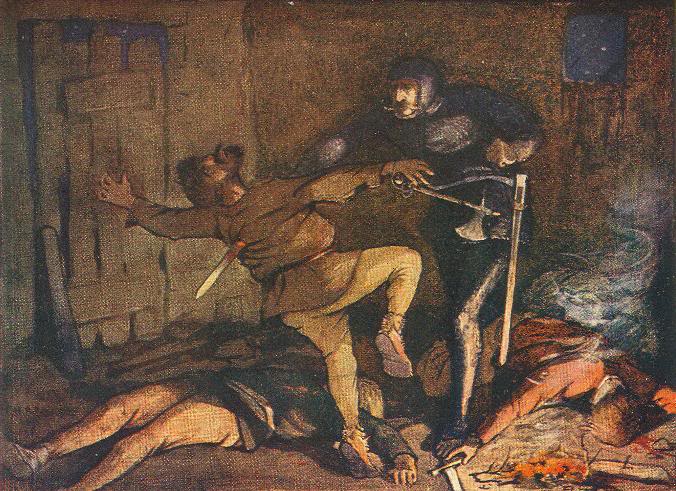Well, i'm searching for one handed battleaxes made in 15th century, but majority of examples is too simplistic.
Among other stuff i found this one.
[ Linked Image ]
Is this one real? I mean this construction looks exactly like smaller version of pollaxe and i never seen such one handed axes before.
Also - if you can present images of other knightly axes made in same age, i would be grateful.
Do you have any information on thaty axe?
As for it being period? I don't have an absolute answer but my gut tells me no. It looks more like someone cut down a polaxe.
Hopefully someone can post some good pictures but I would suspect that most single handed axes (and larger axes for that matter) really are quite plain and utilitarian looking.
Is there a reason for wanting a 15th century axe? And more than just a 15th century axe, are you looking for one from a specific area? I'm sure a Polish axe might be different from a English one.
As for it being period? I don't have an absolute answer but my gut tells me no. It looks more like someone cut down a polaxe.
Hopefully someone can post some good pictures but I would suspect that most single handed axes (and larger axes for that matter) really are quite plain and utilitarian looking.
Is there a reason for wanting a 15th century axe? And more than just a 15th century axe, are you looking for one from a specific area? I'm sure a Polish axe might be different from a English one.
This axe is from wikipedia:
http://en.wikipedia.org/wiki/Battle_axe
"Horseman's axe, circa 1475. This is an example of a battle axe that was tailored for the use of a mounted knight. Note the hole on the haft for the accommodation of a leather strap to be passed over the wrist, the belt-hook for ease of carrying, and the langets. This example dates from the last quarter of the 15th century and is 69 cm (27 inches) long. The wooden haft is modern. The blade's punched decoration suggests German make. Variations of this basic design include the fitting of a hammer face instead of a pointed pick behind the blade."
Danny
http://en.wikipedia.org/wiki/Battle_axe
"Horseman's axe, circa 1475. This is an example of a battle axe that was tailored for the use of a mounted knight. Note the hole on the haft for the accommodation of a leather strap to be passed over the wrist, the belt-hook for ease of carrying, and the langets. This example dates from the last quarter of the 15th century and is 69 cm (27 inches) long. The wooden haft is modern. The blade's punched decoration suggests German make. Variations of this basic design include the fitting of a hammer face instead of a pointed pick behind the blade."
Danny
This german axe must be from late 15th century. There is no other information.
Im interested in axes made in western europe. Reason? Well, it is hard to describe with my limited english skill.
I need weapon to use with shield pavise to participate in reenactor combat events.
IIRC one handed axes were rare choise for knights in 15th century, sometimes as secondary cavalry weapon. Maces, warhammers, swords etc. were used much more often. But due specific circumstances i can choose only some variants of falchion or axe. And i dont want a falchion. So ineed axe that would be good enough for a knight to use.
Im interested in axes made in western europe. Reason? Well, it is hard to describe with my limited english skill.
I need weapon to use with shield pavise to participate in reenactor combat events.
IIRC one handed axes were rare choise for knights in 15th century, sometimes as secondary cavalry weapon. Maces, warhammers, swords etc. were used much more often. But due specific circumstances i can choose only some variants of falchion or axe. And i dont want a falchion. So ineed axe that would be good enough for a knight to use.
Although Robert the Bruce (11 July 1274 – 7 June 1329), is most often depicted using the "simpler Axe" there is one that "pictures the "type with a "spike" -

Here is a "painting" that depicts a similar axe in the hands of RB's foe ( early time in RB's "career")

I do realize that "art" depictions are suspect, but sometimes they they cause us to "think"
Jack

Here is a "painting" that depicts a similar axe in the hands of RB's foe ( early time in RB's "career")

I do realize that "art" depictions are suspect, but sometimes they they cause us to "think"
Jack
Yes. Actualy today i found photo of tapestry from Bern museum. There roman emperor is wielding even more pollaxe-like axe ( with langets and rondel). ANd tha wasnt some poor depiction of pollaxe - warriors around him had normal pollaxes.
This might be slightly later than your interest but Dürer (ca. 1510) shows men-at-arms with pavises and armed with a variety of weapons, including axes roughly the form of A&A's "Hungarian Axe" (follow link) as well as the typical doloire of the period with hatchet-length hafts (see below).
http://www.myArmoury.com/review_aa_hungarian.html
 Attachment: 41.41 KB
Attachment: 41.41 KB

http://www.myArmoury.com/review_aa_hungarian.html

Sean, the axes in your photo are probably hewing axes, not fighting ones. These are of early form later evolved into the "goosewing axe". They look exactly like a doloire on the profile but aside from the short (and sometimes canted) haft their blade is off-centered. Same blade could have been refitted with a long haft but the unbalanced blade makes it awkward to swing, unlike the true doloire. if you look at the socket-to-blade joint you can see a recess caused by the deep hollow of the blade, totaly flat on the other side (as much as I can judge from the pic).
| Sa'ar Nudel wrote: |
| Sean, the axes in your photo are probably hewing axes, not fighting ones. These are of early form later evolved into the "goosewing axe". They look exactly like a doloire on the profile but aside from the short (and sometimes canted) haft their blade is off-centered. Same blade could have been refitted with a long haft but the unbalanced blade makes it awkward to swing, unlike the true doloire. if you look at the socket-to-blade joint you can see a recess caused by the deep hollow of the blade, totaly flat on the other side (as much as I can judge from the pic). |
Correct, it's just the same general form and haft length. I can't find the Dürer image online, but I was struck by the presence--in the front line of battle, no less--of what appears to be an off-the-shelf waggoner's axe. The owner is shown dead, though, so maybe it wasn't such a great idea for him. :D
Page 1 of 1
You cannot post new topics in this forumYou cannot reply to topics in this forum
You cannot edit your posts in this forum
You cannot delete your posts in this forum
You cannot vote in polls in this forum
You cannot attach files in this forum
You can download files in this forum
All contents © Copyright 2003-2006 myArmoury.com — All rights reserved
Discussion forums powered by phpBB © The phpBB Group
Switch to the Full-featured Version of the forum
Discussion forums powered by phpBB © The phpBB Group
Switch to the Full-featured Version of the forum